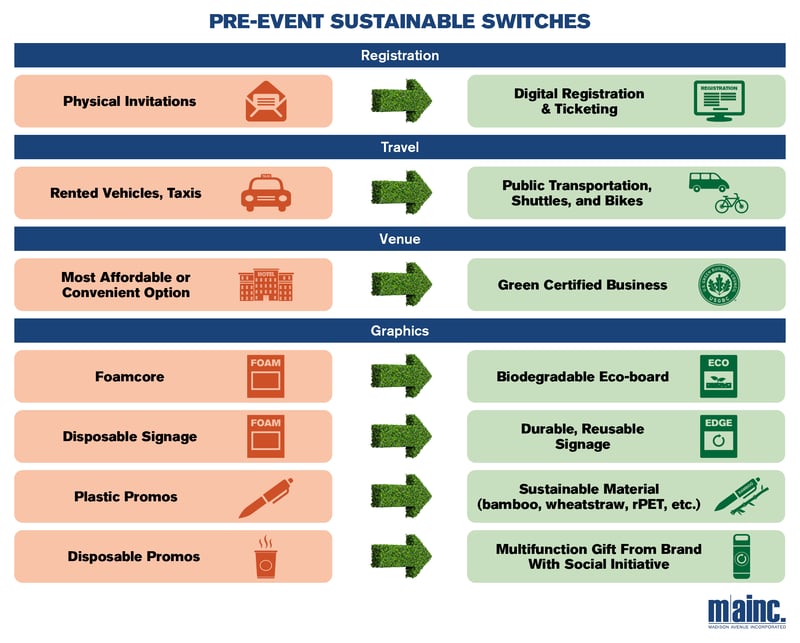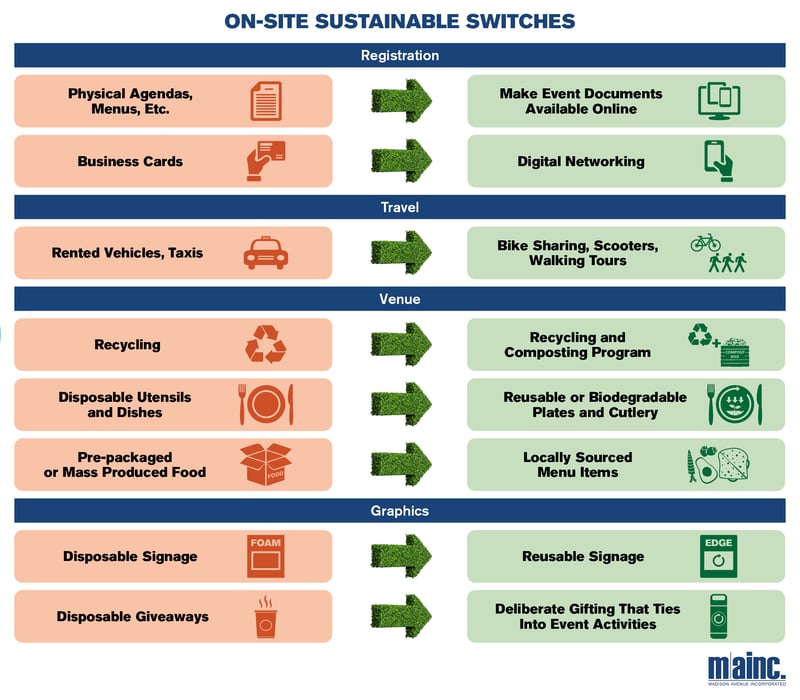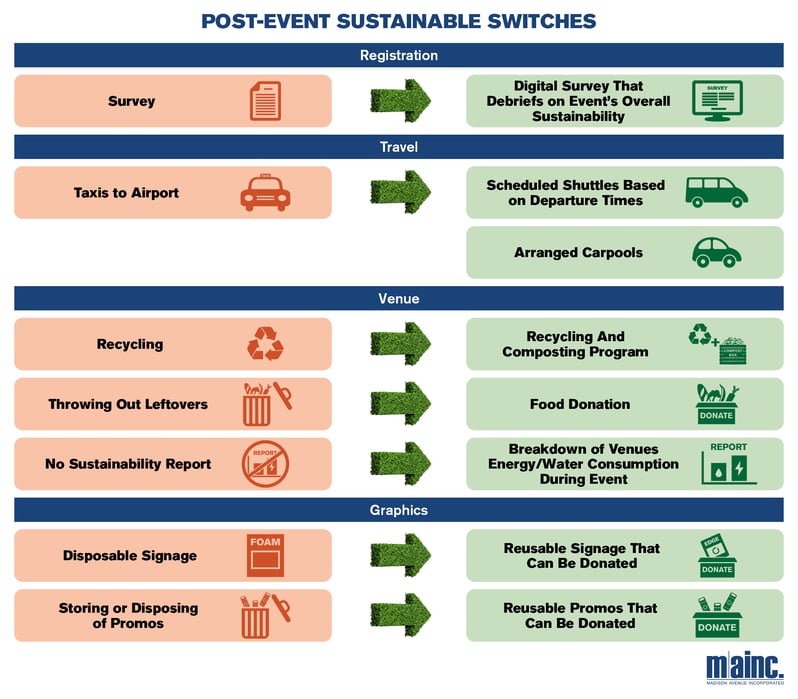As an event planner wearing many hats, you likely have a checklist for planning your next event that is already a mile long. From site selection and event promotion to sourcing giveaways and approving graphic proofs there isn't space on your head for another hat or room on your checklist for another item. With the shift in attendee expectations, many planners are now finding that managing their event’s sustainability is another big check box on their already long to-do list. Whether you’re new to planning green events or simply have too much on your plate as it is, finding ways to make your event more sustainable can be a headache. The good news, you aren’t alone!
We’ve put together some simple switches you can make at your next event to help improve your carbon footprint, without having to add any more items to your already lengthy planning list. Below we'll take you through three stages of your event (pre-event, on-site, and post-event) and provide simple changes you can make at each phase. So, let's dive in and explore the easy steps you can take to make your event more sustainable, from start to finish.
I. Pre-Event
i. Registration
ii. Travel
iii. Vendors
iv. Graphics and Branding
II. On-site
i. Registration
ii. Travel
iii. Vendors
iv. Graphics and Branding
III. Post Event
i. Registration
ii. Travel
iii. Vendors
iv. Graphics and Branding
Pre-event
Registration
When it comes to simple switches during your pre-event registration process, you may be surprised to find you’re already using green options! One of the most effective ways to facilitate eco-friendly registration is to ditch paper and go digital. Encourage your attendees to opt for digital communication and registration processes instead of printed materials. This can include using email for invitations, digital platforms for ticket sales, and creating an online event program guests can access online.
- TIP: Don’t forget to use this point of contact to lay the groundwork for green on-site infrastructure too. Asking attendees to bring reusable water bottles or getting dietary restrictions beforehand to cut down on food waste can help you be a little greener once the event starts.
Travel
Travel emissions are one of the biggest contributors to an event’s carbon footprint. While changes like finding an accessible city that minimizes travel across all attendees isn’t always feasible, there are still simple changes you can make to help prepare your event for more sustainable travel. Consider partnering early with local bike-sharing programs to provide attendees with transportation to use at the event rather than relying on taxis or rented vehicles. Similarly, try to gather information as to when your attendees will be arriving at the airport and provide public transportation information or arrange for shuttles to ferry guests to your venue. Consolidating travel is the easiest way to cut back on travel emissions and their impact on event sustainability.
Vendors
Green events are best hosted in green venues, and making the swap to a green venue is actually easier than you think! Rather than settling for a venue that checks some of your boxes in size or budget, try to include venues that have green certification such as LEED (Leadership in Energy and Environmental Design) or ISO 20121, both of which demonstrate that the venue has sustainable practices. If green certifications aren’t available or the accommodations don’t suit the rest of your event’s needs, consider a venue that uses renewable energy sources (such as solar or wind power) or utilizes some type of sustainable infrastructure (like low-flow toilets and faucets). Simple changes in what you ask for when selecting your venue can actually go a long way when it comes to reducing your event’s overall footprint! Check out our previous sustainable planning blog for more info on vendor certifications!
Graphics and Branding
When it comes to graphics and branding, the simple switch of where you get your materials from can play a huge role in how sustainable your on-site graphics are. Here are some quick and easy switches to consider when planning your signage:
- Opt for biodegradable eco-board signage as an alternative to traditional foam
- Use PVC-free vinyl for banners when available
- Choose vendors who use eco-friendly inks
- Swap plastic giveaways for green materials like bamboo or wheat straw
- Trade disposable signage for reusable signage you can use across multiple events
Substituting biodegradable material like wheat straw and bamboo for your giveaways is a simple way to make your promos a little more sustainable, but there are actually even more ways to bring value to your green giveaways. Partnering with companies that employ some type of social initiative can take your gift to the next level. Clean water initiatives like Welly or Klean Kanteen, climate positive forest restoration companies like Tentree, or 1% to the planet contributors like Patagonia all provide brand equity you can leverage with your attendees to show them your company “walks the walk” when it comes to sustainability. You can learn more about brands with initiatives in our blog!

On-site
Registration
Just like in your planning phase, one of the easiest switches you can make to your on-site registration is to go paperless. Whether through an event app or your meeting’s website, provide event-specific materials like venue layout, breakout schedules, meal menus, and any other important event documentation digitally instead of having physical prints made.
Travel
While encouraging your attendees to carpool and providing public transit information can certainly help reduce the carbon footprint of all the travel during your event’s duration, consider taking the extra step of making carpooling easier for everyone involved! Rather than traditional individual taxis to and from the airport, arrange for shuttles to transport your attendees to and from their destinations with regular pick-up times and drop-off points. This simple switch is not only great for the environment but is one less thing for your guests to worry about when on-site.
- TIP: While public transportation is great at reducing travel emissions, you can minimize your footprint even further by providing bikes or scooters for your guests to use instead of the local bus or taxi services.
Vendors
So you’ve picked your green venue and the big day is here for your event. What changes can you ask your host to make in order to make your event a bit more sustainable? One easy change to make is to the waste collection on-site. While most venues are happy to provide recycling as a standard, check to see if they offer a compost service (or if they’d be okay with you partnering with a local company that collects compost) as a way to minimize your food waste. Considering the average event wastes 20% of the food it produces, composting is a great way to ensure that not all your food waste is actually wasted.
- TIP: Make sure to avoid wishcycling (the act of recycling things that actually can’t be recycled) or missing out on valuable compost material by using volunteers or venue staff to ensure waste gets into the proper receptacles! You can even have a quick waste education session for all guests to learn the ins and outs of your on-site waste management to ensure you’re maximizing your sustainability efforts.
On the subject of food, ask your venue if they can make the change from traditional disposable plates, cups, and cutlery to reusable options. Some venues may even offer biodegradable options or reusable options made from sustainable materials like wheat straw! Rather than prepackaged or mass-produced branded food, see if your venue can source menu items locally. This cuts down on transportation emissions on top of tasting fresher.
- TIP: The increase in bleisure travel means that people are more likely to want to be immersed in the local attractions of your host city. Consider opting out of a meal one evening and allocating those budget dollars to a shuttle downtown for guests to enjoy local cuisine at a restaurant of their choice and do some shopping! This not only prevents some food waste but also adds to the overall attendee experience of your event.
Graphics and Branding
Earlier we discussed changing out your traditional disposable signage with reusable or biodegradable substrates and inks and how to leverage a brand’s social initiative to bring some additional value to your giveaway and event. Did you know you can actually elevate your giveaway and branding further by incorporating them into the on-site experience for your guests?
- TIP: A reusable wheat straw drinking bottle is a great pick for the immediate use of eliminating single-use plastics or disposable cups on-site and can tag along with attendees on a guided walking tour of the host city. Incorporating your gifts into deliberate and mindful experiences make for a more memorable experience and a potentially greener event! Be sure to check out our Networking Blog for some ideas on how to better incorporate your giveaway into your activities!

Post-Event
Registration
Just like pre-event registration, when it comes to post-event data collection most of us have already made the most sustainable swap of going paperless. Send your surveys via e-mail, but don’t just use this post-event time to educate yourself, educate your guests as well! Use your event app or sustainability consultant to analyze the waste generated during the event (and how much was mitigated by way of recycling or composting) as well as energy consumption and how much of it was via renewable sources to share with your attendees. This data not only helps you identify areas you can improve for your next event, but the transparency cultivates the sense that your company is doing its part to move the industry in a greener direction.
Travel
Just as with on-site shuttles to and from local spots of interest, so too can shuttles be used to move attendees to the airport or bus station for their departures. The data you collected in the pre-event stage can be used here to arrange shuttles based on departure times.
Vendors
While the recycling and composting programs you’ve set up will help with the waste produced by your event, you may find yourself with leftover food that isn’t necessarily “waste”. While leftovers can be disposed of or, ideally, composted, you do have some options to keep this food out of a landfill. See if your venue partners with any local community centers, shelters, or non-profits that can receive donated food. Preventing usable items from going to waste unnecessarily is what sustainability is all about!
Graphics and Branding
We don’t typically think about graphics or giveaways as being “leftovers” the same way we do with food, but signs and promos that are no longer needed after an event can be upcycled as well! Rather than tossing your signage or keeping leftover water bottles in an office closet till your company’s next spring cleaning, consider donating reusable signage to libraries, schools, or community centers.
- TIP: Reusable signs can be painted over with chalkboard paint or dressed up with sign decals for a new look to better suit their new role.
Promo items can also be donated and companies like Swagcycle can take your leftover giveaways for use at shelters and local YMCAs. Donating rather than tossing or storing indefinitely is a great way to keep your event graphics and branding green, even when they’ve outlived their use!

Small Changes, Big Impact
Change doesn’t have to happen overnight and small changes to how you approach your event sustainability now can help save you time and money in the future. So whether you’re doing just one thing from the list at your next event or plan to incorporate all these ideas, little changes now can save you from having to make big changes in the future. If you’re looking for more resources, we’ve created an entire series of sustainability blogs to assist you, no matter your experience level! As always, our helpful customer relations team is standing by ready to assist with any questions you might have or to help you get started planning your next green event, so contact us and together we can start laying the groundwork for a greener future for our attendees, our industry, and our planet!

